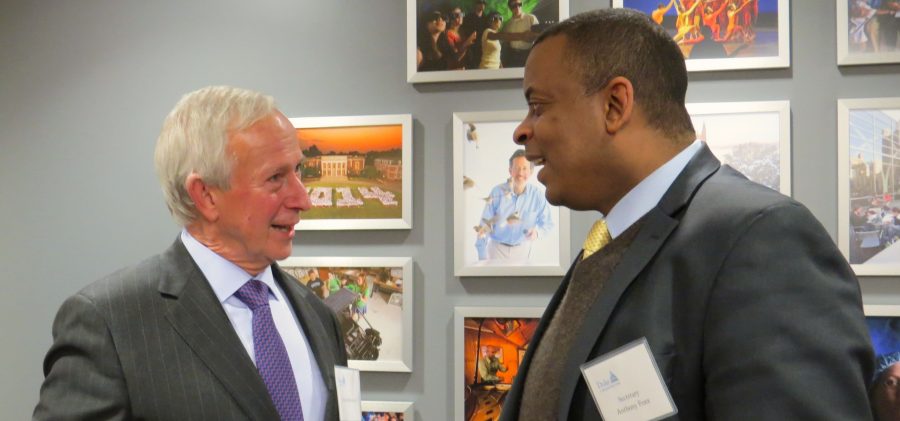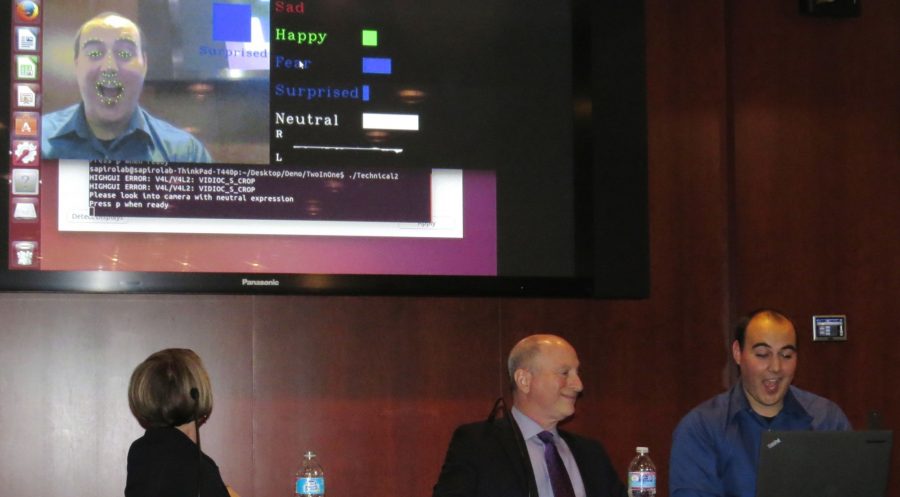700 synapses a second. That is the rate at which the brain develops new neural pathways in the first few years of life. In fact, science has shown that this early time period is so critical for proper development, that disruptions in this stage of life can have drastic lifelong impacts.
As recently as ten years ago, there were disputes about whether or infants and toddlers even experienced mental health problems at all. Now, the existence and prevalence of early childhood mental health disorders is widely accepted, but 75-80% of these kids never even receive treatment.
What’s more, even when families do have access to care, in many cases, like for kids with autism, they don’t receive a diagnosis until age 5.
So what is to be done about it?
A team of Duke researchers traveled to Washington, DC on December 4 to brief an audience of congressional staff, agency representatives, and child mental health advocates on Duke efforts to address just this question.
Dr. Helen Egger, chief of the Division of Child and Family Mental Health and Neuroscience; Dr. Guillermo Sapiro, professor of electrical and computer engineering; and Dr. Robert Calderbank, director of the Information Initiative at Duke, gave a presentation on their collaborative venture, The Duke Information and Child Mental Health Initiative.
The initiative is an interdisciplinary effort that seeks use advances in information science to bring transformative change to the field of early childhood mental health.
Or as Dr. Egger explained, the effort aims to “use technology to bridge the gap between what we know and what we do.”

Dr. Helen Egger, a world-renowned expert in early childhood mental health, addresses challenges facing the field.
Current Challenges
The team, joined by Matthew Melmed, executive director of ZERO TO THREE, an organization focused on promoting healthy early childhood development, spent an afternoon at the Capitol Visitors Center outlining the current barriers to effective treatment and how the initiative provides solutions to these challenges.
Dr. Egger pointed out that current solutions are expensive, time-consuming, and not widely-available. Demand for services is far outpacing supply, and providers are failing to meet the needs of these kids as a result.
For an illustration of this problem, Egger provided statistics on Duke’s experience with autism, just one type of childhood mental health disorders.
According to Egger, since 2004, the number of autism-related clinical visits at Duke Medicine has increased 300%. “Even though we saw 3,000 children with autism last year, we still have a year waiting list for people to get in to be seen.”
At What Cost
Matthew Melmed emphasized some of the costs of not getting treatment to the kids who need it.
He pointed to a study in Illinois that showed that 42% of childcare centers surveyed had to ask toddlers to withdraw due to an inability to handle their behavioral and emotional problems.
Said Melmed, “These kids had challenges but we were not responding in appropriate ways and meeting their needs. We were throwing them out of preschool. These kids were labeled as failures before they even got to kindergarten.”
Melmed also highlighted the effect on parents who have to miss work to care for kids experiencing problems.
“What happens when a child has lots of emotional and developmental delays? It has a big impact on their parents and therefore has a big impact on their ability to be productive workers in our society.”
Egger said that in 2011 alone, mental health disorders cost the U.S. $2.5 trillion. These disorders, Egger said, are rooted in early childhood.
A Better Way
Egger said that improving access to care begins with developing better screening and diagnostic methods, and this is the initial focus of the Duke Information and Child Mental Health Initiative. The team is made up of experts from all over Duke who are working to create and refine innovative tools that aim to increase access to screening and, ultimately, information.
One of these tools is an app that fuses Sapiro’s work in computer vision with the expertise of Egger and autism expert Geraldine Dawson to determine a toddler’s risk for the disorder.
Current methods to determine whether or not a child is at risk for autism include a trained clinician observing and evaluating that child on two key factors: whether the child turns his head in response to his name and whether he responds emotionally to simple stimuli.

Grad student Jordan Hashemi demonstrates expression recognition software during the panel discussion.
Sapiro demonstrated how the Duke technology differs from current screening methods by showing a short video of a clinician performing this autism risk assessment.
“What the expert is trying to [do], she is counting in her head, ‘1…2,'” said Sapiro. “She is doing the exercise and has to also say if it takes less than a second or more than two [seconds for the baby to turn his head]. More than two [seconds] is a delay,” Sapiro said.
Speaking of his software that automates this analysis of response time, Sapiro explains, “I can tell you 30 times per second exactly what the baby is doing. Automatically.”
The app also aims to automatically analyze the second factor, the emotional responses of a baby as she watches a video. Drawing on algorithms that interpret facial muscle movements, the app will record a toddler’s emotions while she interacts with what’s on the screen. These recordings are then instantly compared to how experts would expect a child with healthy development to react to the stimuli.
Rather than secure an appointment, sit in a waiting room, and endure interactions with strangers in strange settings, a parent could simply stay at home and have the child play with an app on a phone or a tablet.
Big Access AND Big Information
Millions of people around the world have access to mobile devices, and the team hopes this means that millions will have access to these screening tests. At the same time that they are increasing access, the researchers will be collecting data from individuals using the app to build a first-of-its-kind, comprehensive knowledge database for early childhood mental health.
As Sapiro said at the briefing, “How can we understand abnormal if we don’t understand normal?”
Although Egger’s research includes studies of the brain development of thousands of young children, Sapiro emphasized that to truly understand the state of early childhood mental health, researchers need access to much larger sample sizes.
Sapiro recalled, “I asked Helen how many people she can see in her lifetime. Every big data person will laugh at the number. There is no way to understand normality with the number of children Helen sees.”
By putting the app in the hands of kids around the world, Sapiro says, “We’re going to be able to start collecting millions and millions and hundreds of millions [data points].”
The researchers hope that as more and more data is collected, they will be able to understand “normality” in a way that is impossible if the data were drawn from the research of just one person. Ultimately, says the team, the database will become a widely-accessed, science-based knowledge bank for clinicians and parents alike.
****

Victoria Bright (T ’10), legislative correspondent for Rep. Nancy Pelosi, tries out the expression recognition software after Thursday’s briefing.

Jordan Hashemi, Duke PhD candidate in electrical and computer engineering, leads an audience member through a demonstration of the expression recognition software.

Robert Calderbank, director of the Information Initiative at Duke, discusses the early childhood mental health initiative with a representative from the Department of Defense.
****
The December 4th event was the second in a series of briefings highlighting the efforts of the Information Initiative at Duke (iiD), an interdisciplinary initiative to use information science to address challenges that face society. Read more about a briefing back in June of 2014 that highlighted the iiD’s work in the fine arts here: https://governmentrelations.duke.edu/big-data-and-the-arts/
****
Duke in Washington seeks to connect faculty research and expertise to a Washington audience – the people and organizations who work on the important issues facing our nation and world. For more information on these and other scholars at Duke, please contact us.












